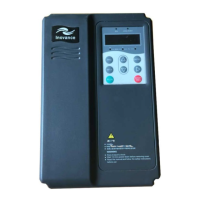32
the main frequency source can be adjusted to a negative value through the UP/DOWN button.
However, the final frequency shall range from 0 to the maximum output frequency. In this way, the
main frequency and the auxiliary frequency can be flexibly adjusted between 0 and maximum output
frequency.
F0-04 Digital preset frequency
Default 50.0
Setting range 0.0 ~ maximum frequency (valid when the
frequency source adopts digital setting)
F0-05 Acceleration time 1
Default 20.0
F0-06 Deceleration time 1
Default 20.0
Setting range 0.0s ~ 3000.0s
Acceleration time refers to the time required for the inverter to accelerate from 0Hz to the maximum
output frequency (F6-00).
Deceleration time refers to the time required for the inverter to decelerate from maximum output
frequency (F6-00) ~ 0Hz.
When the setup frequency is equal to the maximum output frequency, the actual
acceleration/deceleration time is the same with the set acceleration/deceleration time.
When the set frequency is less than the maximum output frequency, the actual
acceleration/deceleration time is less than the set acceleration/deceleration time.
Actual acceleration/deceleration time = set value ×(set frequency/maximum output frequency)
F0-07 V/F curve setting
Default 0
0 V/F curve
1 Reserved
Setting range
2 Square V/F curve
0: Line V/F curve, applicable to loads with ordinary constant torque
1: Reserved
2: Square V/F curve, applicable to centrifugal loads, such as fan and pump.
F0-08 V/F control torque boost
Default 3.5%
Setting range 0% ~ 30.0%
To compensate the effect caused by low frequency stator resistance, boost compensation is made
to the inverter output voltage. The startup performance under the V/F mode can be improved when
the boost is set appropriately. When the boost is 0, the inverter will automatically make the
compensation according to the motor parameters.

